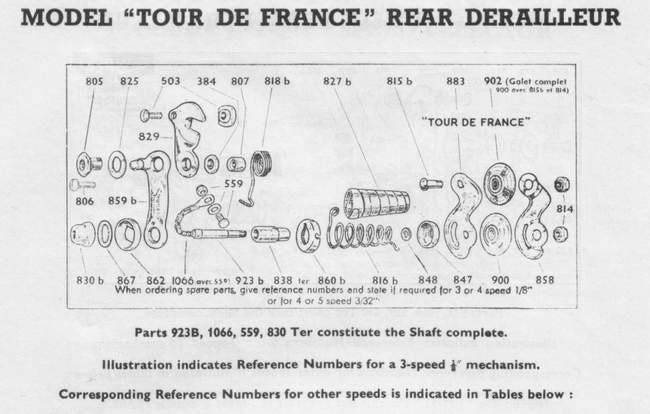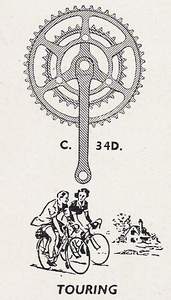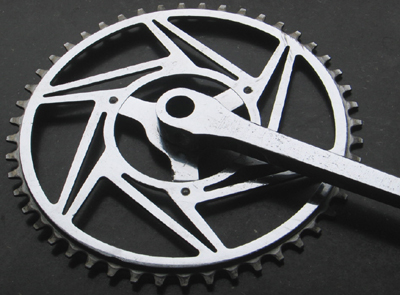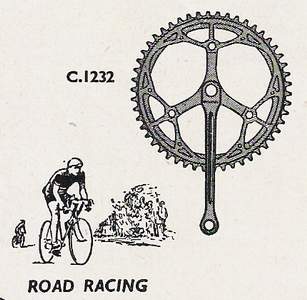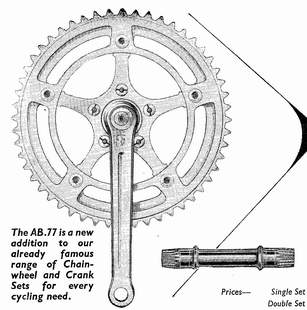A Guide to Williams Crank and Chainring Identification
Posted: Monday 21st September 2020
This guide has been produced because:
- Williams are wrongly in my view judged by their base model the C34. Would we judge Brooks by the B5 or Campagnolo by the Valentino gear?
- It can be difficult to identify different models and because their advertisements before 1955 are often Professor Eddywilly cartoons, which although are amusing are not helpful to identification.
| Model | Date | Ring Sizes | PCD | Details |
| C28 | 30's | 44,46,48 | C34 | Pre-war only same cranks but different chaining design Marked 410207 |
| C34 | Late 20’s to 62 | 32-60 even. Inch pitch 16-30 | 88mm | Most common model. Swaged on ring arms. Chainrings flanged on outside only. Production stopped in 1962 but chainrings continued to be made until the end of the 60's. Fluted version 1s 4d extra in 1962. Single and double fluted made. Sleeved fitting 1s 8d more expensive in 1962. Cranks in three options: square, half-round and fluted. |
| D34 | 30's to mid 60's | Outer as C34 but inner 6-pin fitting to outer ring | C34 | Tandem version |
| SC31 | mid 30's to end of 50's | No PCD as one ring is fixed | Tandem fixed inner-ring, outer detachable 6-bolt fitting | |
| C45 C45D Double | 54 to early 60s | 44 46 47 48 49 50 3/32 & 1/8 | C34 | Triangle ring pattern designed to allow easy chainring removal, i.e. without taking off pedal. Same cranks as C34 sleeved only. |
| C1000 | 54 to early 60s | 32-48 even | C34 | Described as club racer set, lighter cranks and rings than C34, weight with 46t, 756g |
| C1032 | Early 50's to 61 | 44-52 even | C34 | Double: square screw fixing of both rings (version of C1000). I think the 32 stands for 3/32 chain. |
| C1200 | 39 to 67 | 44-54 including odds 47 & 49 no's | 116mm continental size. Open-claw design | The top model 6¾ only. Fluted cranks top quality forged right crank one piece. Rings driven by bosses on ring not chainring bolts, better design than Chater-Lea. Both sleeve and screw ring fitting. Weight with 46t, 700g |
| C1232 | 54-mid 60's | As above 3/32 only | As C1200 | Double version of C1200 |
| LC1232 | 54-mid 60's | 46-54 including odds 47 & 49 3/32 only | C1200 | Double sleeve fiting to crank. Inner ring six screw bolt fitting to outer.Different ring design and wider crank arms (like C34) than C1200. The 32 stands for 3/32 chain |
| LC1200 | 61 to late 60's | 44-50 | As C1200 | Replaced the C34. Fluted 6¾ only. Wider chainring arms than C1200 swaged on. Sleeve fitting only. |
| B100 | Late 30's to early 70's | 26 to 56 also inch pitch | BSA 5 pin | Plain cranks base model. With fettling interchangeable with TA |
| B1100 | Mid 30's to late 40's | 44, 46, 48 | BSA 5 pin | Cranks as B100 rings without inside flange |
| B109 | Pre-war | 44, 46, 48 | B100 | Dureel ring, weight with 46t 560g. Same cranks as B100 |
| F100 F45 | 30's to 60's 54 to late 60's | 44, 46, 48 | n/a | Fixed ring version, chainring design as per model letter, e.g. F45 as C45 |
| AB77 Cotterless | 62 to mid 70's | Minimum 42 made by Williams but interchangeable with TA minimum 26. Also adaptor - see below | 5 pin as TA | Splined b.b. made by TDC (poor quality). High quality cranks, all alloys. Benefit over Gnutti splined is that no need for special tool to remove cranks. 6 ¾" only. The only British cotterless crank made in any quantity |
*PCD: pitch circle diameter. Diameter of circle joining the centre of the crank bolt holes also known as BCD, bolt circle diameter.
Other products
Adaptor to fit 5 pin TA/AB77 cranks and take 151 PCD chainrings (Campagnolo’s original design until 1967 when they changed to 144 PCD).
Alloy 151 PCD chainrings 44 to 56.
Both above products introduced 1962
Williams accepted special orders. This included rings up to 64t, special chainring design and bevelled edge cranks.
Pre-war special flush fitting cotterpins and dureel fixed sprockets
Cranks made in non-gearcase clearance (NGCC) also made in gearcase clearance (GCG)
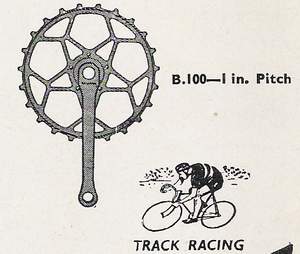
Chainring fittings
Until 1954 all Williams cranks used the screw square bolt method of attachment (also used by BSA). With the introduction of the C45 a larger splined hexagonal sleeve fitting was introduced . The main reason for this switch was the latter was far easier to accommodate double chainrings, which were becoming more widespread. Well into the 60’s Williams continued to offered cranks with the original square bolt fitting.
“Williams the conquerors of transmission troubles” (long running strap line to advertisements, a pun on William the Conqueror)
Abbreviations used by Williams in their literature:
B 5 pin BCSA type rings
D for tandem as prefix of double chainring as suffix e.g. C45D
F fixed ring
LC fluted and sleeved fitting for doubles
SD semi-detachable
NGCC & GCC none and gear case clearance, C34 offered in both versions
J joggled fixed ring made by stamping no flange cheapest quality

Dating/Marking:
All products are either marked E.B.W. with the sword trademark in the middle and/or stamped Williams (on cranks). The latter is etched very lightly into chrome surface only.
C1232 outer ring marked: RD874905
C45 rings marked: REGDAPPDFOR
Alloy adaptor is marked: regd 909182 (the patent number).
Alloy 151 PCD rings: regd 908786
Year of manufacture is marked on the cranks and rings, usually below the sword (only exception the alloy rings and adaptor). This is usually on the inside of the ring and inside of crank near the cotter pin. This is one of the most useful guides to dating a bike providing the cranks and/or chainring is original. See the Williams component dating table.
Size
Majority of Williams cranks were available in 6½” and the C34 in 7″. Exception was the LC1200 and C1200 only in 6¾.
Demise
In the late 70’s production was taken over by Nicklin who made a greatly reduced range based around the C34. Nicklin were a trade competitor from before WW2, their products were of the C34/B100 standard and not held in regard by club cyclists. They were a major supplier for mass produced British manufacturers e.g. Raleigh, Dawes, Falcon etc They had made a fluted version of the C34, the N34 since 1963 when Williams ceased production of this model. Part of the Williams factory in Smethwick, Birmingham still stands today but is derelict.
Posted: Monday 21st September 2020
This article appears in the following categories.
Upcoming Events
Whether you are looking for a gentle social meet up, or a 100-mile ride browse the community’s upcoming events and plan your next weekend outing.
